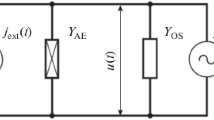Abstract
A mathematical model of the autodyne radar with frequency modulation has been developed. The model is presented in the form of a self-excited oscillator with single-loop oscillating system adjusted in terms of frequency by varying the varicap capacitance. This model takes into account the impact of intrinsic radiation reflected from the object of location and inherent noises of the generator, as well as the power source noises. Basic expressions were derived for the calculation of the signal accompanying the spurious response of generator, components of the legitimate signal and the noise during the registration of autodyne response both in the power supply circuit and in terms of the variation of oscillation amplitude. Calculations of noise characteristics were carried out at small and large values of the feedback parameter. The phenomenon of periodic nonstationarity of noise levels at the autodyne generator output was detected in conditions of strong feedback. The results of calculations and experiments were obtained for the autodyne built on an 8 mm-band Gunn diode.
Similar content being viewed by others
References
S. A. Alidoost, R. Sadeghzade, R. Fatemi, “Autodyne system with a single antenna,” Proc. of 11th Int. Radar Symp., IRS–2010, 16–18 Jun. 2010, Lithuania, Vilnius (IEEE, 2010), Vol. 2, pp. 406–409, http://ieeexplore. ieee.org/document/5547497/.
S. Kim, B.-H. Kim, J.-G. Yook, G.-H. Yun, “Proximity vital sign sensor using self-oscillating mixer,” Proc. of URSI Asia-Pacific Radio Science Conf., URSI AP-RASC, 21-25 Aug. 2016 (IEEE, 2016), pp. 1446–1448, DOI: 10.1109/URSIAP-RASC.2016.7601402.
V. Ya. Noskov, K. A. Ignatkov, A. P. Chupakhin, “Application of two-diode autodynes in devices for radiowave control of product dimensions,” Meas. Tech. 59, No. 7, 715 (2016), DOI: 10.1007/s11018-016-1035-9.
G. P. Ermak, I. V. Popov, A. S. Vasilev, A. V. Varavin, V. Ya. Noskov, K. A. Ignatkov, “Radar sensors for hump yard and rail crossing applications,” Telecom. Radio Eng. 71, No. 6, 567 (2012), DOI: 10.1615/TelecomRadEng. v71.i6.80.
V. Ya. Noskov, A. V. Varavin, A. S. Vasiliev, G. P. Ermak, N. M. Zakarlyuk, K. A. Ignatkov, S. M. Smolskiy, “Modern hybrid-integrated autodyne oscillators of microwave and millimeter wave ranges and their application. Part 9. Autodyne radar applications,” Uspekhi Sovremennoi Radioelektroniki. Zarubezhnaya Radioelektronika, No. 3, 32 (2016), http://www.radiotec.ru/catalog.php?cat=jr4&art=17683.
I. V. Komarov, S. M. Smolskiy, Fundamentals of Short-Range FM Radar (Artech House, Norwood, 2003), DOI: 10.1109/MAES.2004.1346903.
S. D. Votoropin, V. Ya. Noskov, S. M. Smolskiy, “An analysis of the autodyne effect of oscillators with linear frequency modulation,” Russ. Phys. J. 51, No. 6, 610 (2008), DOI: 10.1007/s11182-008-9083-5.
V. Ya. Noskov, K. A. Ignatkov, A. P. Chupakhin, A. S. Vasiliev, G. P. Ermak, S. M. Smolskiy, “Peculiarities of signal formation of the autodyne short-range radar with linear frequency modulation,” Visn. NTUU KPI, Ser. Radioteh. Radioaparatobuduv., No. 67, 50 (2016), http://radap.kpi.ua/en/radiotechnique/article/view/1366.
V. Ya. Noskov, K. A. Ignatkov, “Peculiarities of noise characteristics of autodynes under strong external feedback,” Russ. Phys. J. 56, No. 12, 1445 (2013), DOI: 10.1007/s11182-014-0198-6.
V. Ya. Noskov, G. P. Ermak, “Signal and fluctuation characteristics of autodyne vibration and displacement meters,” Telecom. Radio Eng. 73, No. 19, 1727 (2014), DOI: 10.1615/ TelecomRadEng.v73.i19.30.
V. Ya. Noskov, K. A. Ignatkov, “About applicability of quasi-static method of autodyne systems analysis,” Radioelectron. Commun. Syst. 57, No. 3, 139 (2014), DOI: 10.3103/S0735272714030054.
V. Ya. Noskov, K. A. Ignatkov, “Autodyne signals in case of random delay time of the reflected radiation,” Telecom. Radio Eng. 72, No. 16, 1521 (2013), DOI: 10.1615/TelecomRadEng.v72.i16.70.
A. V. Varavin, A. S. Vasiliev, G. P. Yermak, I. V. Popov, “Autodyne Gunn-diode transceiver with internal signal detection for short-range linear FM radar sensor,” Telecom. Radio Eng. 69, No. 5, 451 (2010), DOI: 10.1615/TelecomRadEng.v69.i5.80.
V. Ya. Noskov, K. A. Ignatkov, “Noise characteristics of autodynes with frequency stabilization by means of an external high-Q cavity,” J. Commun. Technol. Electron. 61, No. 9, 1052 (2016), DOI: 10.1134/S1064226916090102.
Author information
Authors and Affiliations
Corresponding author
Additional information
Original Russian Text © V.Ya. Noskov, A.S. Vasilev, Gennadiy P. Ermak, K.A. Ignatkov, A.P. Chupakhin, 2017, published in Izvestiya Vysshikh Uchebnykh Zavedenii, Radioelektronika, 2017, Vol. 60, No. 3, pp. 154–165.
This study was carried out in accordance with the Agreement on scientific and technical cooperation between UrFU University and IRE Institute of NASU and with financial support of the Russian Government, Resolution No. 211, Contract No. 02.A03.21.0006.
About this article
Cite this article
Noskov, V.Y., Vasilev, A.S., Ermak, G.P. et al. Fluctuation characteristics of autodyne radars with frequency modulation. Radioelectron.Commun.Syst. 60, 123–131 (2017). https://doi.org/10.3103/S0735272717030049
Received:
Published:
Issue Date:
DOI: https://doi.org/10.3103/S0735272717030049




